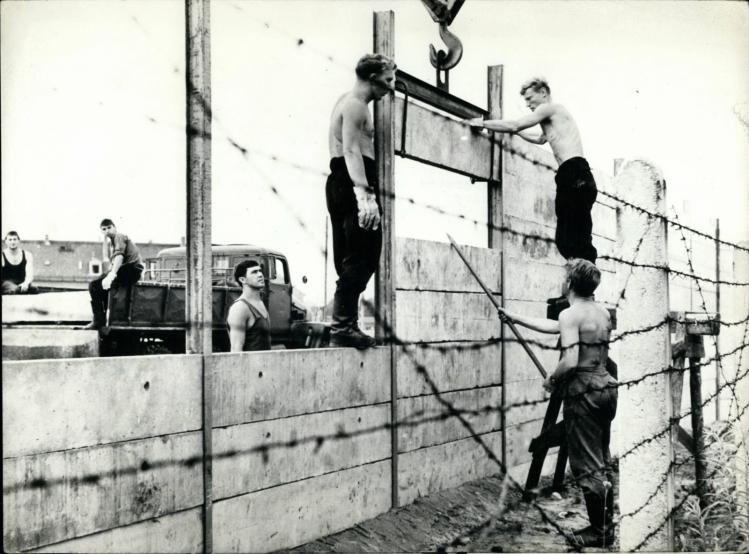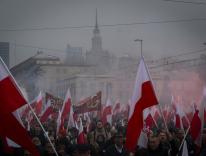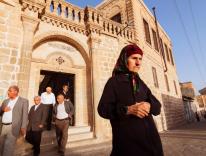
If you want to impress someone from western Germany with your German-language ability, or frighten an elderly eastern German, try out this mouthful: Stacheldrahtsonntag. Translation: “Barbed-Wire Sunday.” Most Germans still know what it means—and Germans over the age of sixty-five cannot forget the day it happened, and where they were and what they were doing. It is a marker of generational consciousness, comparable to how Americans over sixty can still recall exactly how and when they heard that President John F. Kennedy was shot.
August 13, 1961. This was the day East Berliners woke up to find their half of the city encircled by barbed wire—and themselves incarcerated in a state-wide prison, separated from friends and families. Stacheldrahtsonntag. On that shocking day, the military and police of East Germany—officially known as the German Democratic Republic (GDR)—closed the border between East and West Berlin and began the construction of what would, within weeks, become the towering Berlin Wall, complete with 296 watchtowers and thousands of army snipers. Why the barbed wire? It was a fast and relatively cheap way to prevent border crossings until the big construction crews got to work on the concrete wall itself.
Seventeen million people were trapped inside the GDR overnight, and 533,000 East German troops and police amassed near the border to make sure no one escaped. On August 13 and 14 at least four thousand GDR protesters were arrested by the secret police. By the morning of August 18, the foundation for the concrete wall had already been laid.
Why close the border? To prevent the West Germans and Americans from invading the GDR! So declared the GDR’s state-controlled radio and TV stations to the skeptical East German public. Die Schutzmauer (“the Wall of Protection,” often expanded to “the Anti-Fascist Wall of Protection,” in case there was any doubt about what the citizens of the GDR had to be protected from) was the term used in all East German schoolbooks—as I discovered when I taught in East Germany after the Berlin Wall came down in 1989. Over the following year, thousands of outraged citizens rose up and rebelled, marching through the streets month after month, peacefully protesting the decades of tyranny. These demonstrations finally brought down the Communist regime without a bloodbath.
But back to 1961 and the construction of what the GDR populace called das Unding (“the monstrosity”)—and West Germans referred to as die Schandmauer (“the Wall of Shame”). Shameful it was. “Something there is that doesn’t love a wall,” wrote Robert Frost in “Mending Wall.” Die Schandmauer became a propaganda boon for the West, the horrifying symbol of Communist tyranny during the Cold War—the scene of famous protest visits by American presidents from Kennedy in 1963 (“Ich bin ein Berliner!”) to Reagan in 1987 (“Mr. Gorbachev, tear down this wall!”). Contrary to the hopelessly tendentious GDR history textbooks, the Berlin Wall’s purpose was not to protect against an invasion from the West, but rather to prevent the migration of East Germans to the West.
And with good reason, or so it must have seemed to the GDR government. For already within a dozen years—from the founding of the GDR in October 1949 to the erection of the wall in August 1961—3.5 million East German citizens (about 20 percent of the population) had defected to West Germany, most across the Berlin border because of its lack of security. (The rest of East Germany was already either surrounded by barbed wire or policed by watchtowers and army snipers. These effectively deterred all attempts to cross except at Checkpoint Charlie, the official exit and entry route.) In short, the hapless East German regime was hemorrhaging to death, and something had to be done to halt the flow of defectors. That something was the wall.
And so it happened—in secrecy and in stealth, in the early morning hours of Sunday, August 13. East German troops arrived at certain points to unload concrete, barbed wire, shovels, and stone blocks. Secret police agents were stationed at major intersections between the Soviet and Western sectors of Germany. Around 4 a.m., radio reports of commotion in the streets were being broadcast in West Berlin. By 4 p.m., half a million Berliners from both the West and East were congregating around the border between East and West Berlin. While police in West Berlin held back West Berliners who were calling for action, police in East Berlin were keeping East Germans away from the construction.
Despite the measures taken by police, 800 people managed to escape East Berlin before the end of that day. They had to get through or over barbed wire, or jump through house windows at the sector border. That day, dozens died in the attempt to get across; at least 588 people (and twenty-five border guards) died in the decades that followed. After Stacheldrahtsonntag, only a few hundred intrepid souls managed to escape the GDR. That is, until the ecstatic, unforgettable day of November 9, 1989, when hundreds of thousands of joyous citizens danced atop the wall and millions “escaped” by simply walking a few meters across the border to West Berlin, many of them for the first time in their lives.
Please email comments to [email protected] and join the conversation on our Facebook page.
Share
Previous Story
The Art of Survival
Next Story
An Impossible Job


